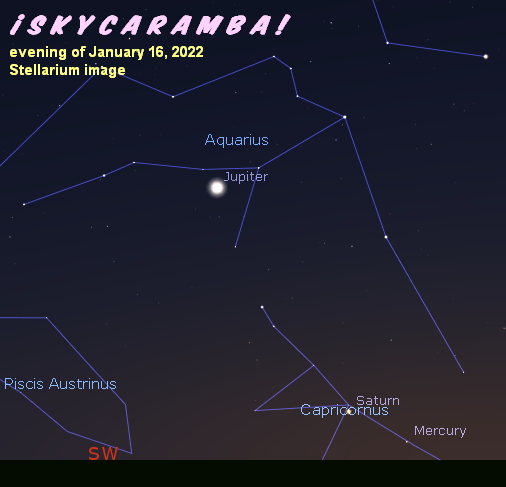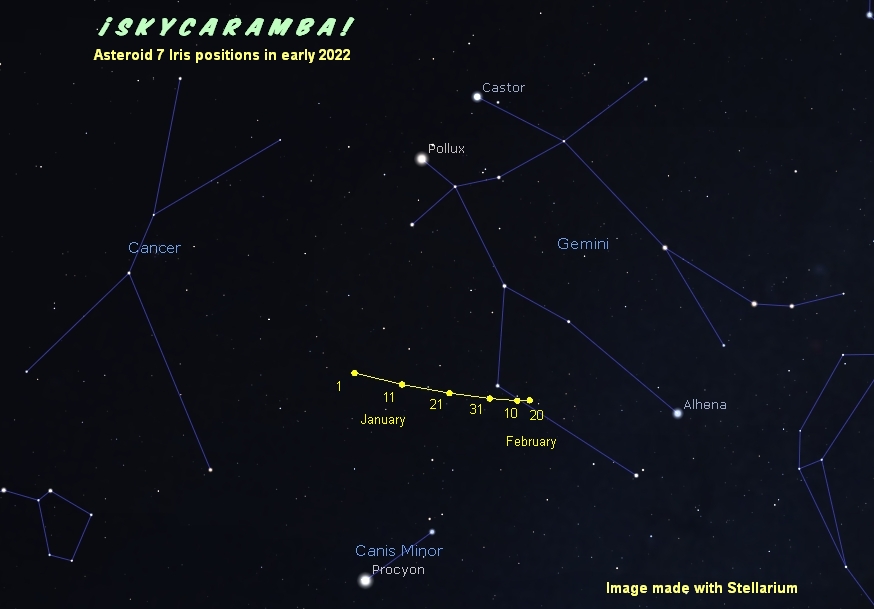
We start a new year with four naked eye planets in the evening sky. One is already on the way out of the party and it won’t be long before the rest follow it to the morning sky. You may be able to see Venus very close to the horizon in the southwest as darkness begins on the just the first few evenings of the month. Mercury is above it. Then you see Saturn in Capricornus. Continuing up the sky, you find Jupiter settling into Aquarius.

On the 3rd, the same day that Earth is at perihelion, a thin sliver of a young moon is near Mercury. Each night, the crescent is thicker and passes Saturn on the 4th and Jupiter on the 5th. Mercury is at greatest elongation on the 7th. It’s 19.2° east of the sun. On the 8th, Venus goes through inferior conjunction. The moon is at first quarter the next day.

About a third of the way into the month, Mercury doesn’t seem quite so eager to meet up with Saturn. They get as close as 3.4° when Mercury turns around and starts a sunward trek. Mercury’s at perihelion on the 15th. The moon is nearly full on the 16th when it’s at northern lunistice 26.4° from the equator. Full moon is on the 17th. About two-thirds of the way through January, Saturn becomes hard to see as it’s setting not long after sunset. Of course, even though Jupiter is higher, you know it is also heading toward the morning sky. You have a few more weeks to enjoy it as an evening object.

Venus will be visible in the morning sky by the middle of the month if you have a clear horizon and vision astute enough to pick it out of the morning light. It and Mars are heading toward each other. On the 23rd, Mercury has disappeared from the morning sky and goes through inferior conjunction. On the same day, Venus is at perihelion.
The moon is at last quarter on the 23rd. It’s on the way to southern lunistice at 26.4° from the equator on the 29th. By this time, Venus is much easier to spot in the morning sky. It and Mars pass each other around the 27th. A waning crescent moon is nearing them and passes by them on the Mars side on the 29th. Mars is right of Venus and ends the month atop the Sagittarius teapot.

The asteroid Iris is at opposition on the 13th, 1.1 astronomical units from us and just east of Gemini.
The Quadrantid meteor shower peaks on the 3rd. Asia and Europe will get the best of it. It’s daytime during the peak in the Americas. And it’s a far northern shower, so Africa, Australia, and South America don’t get much of it at all. It will be possible to see a Quadrantid meteor in the southern hemisphere if it makes a long trail on the way through the atmosphere. But you can’t tell with any certainty that it’s coming from the shower’s radiant point.
A good callenge this month would be seeing a thin crescent moon next to Venus twice. They’ll be 7.5° apart on the 3rd when the planet’s still in the evening sky. You may need binoculars or a telescope to see both so soon after sunset. Definitely make sure the sun is down before you point any scope or binoculars in that direction. You won’t have nearly as much trouble finding the planet in the morning on the 30th with the moon and Mars nearby.
